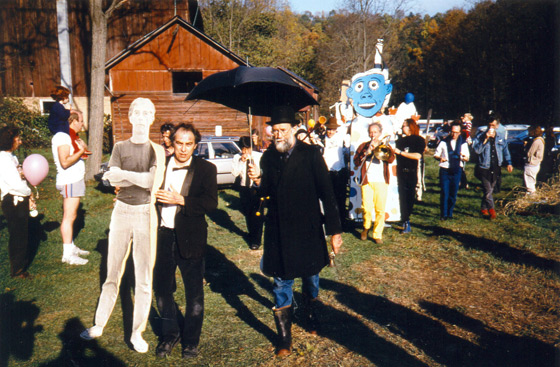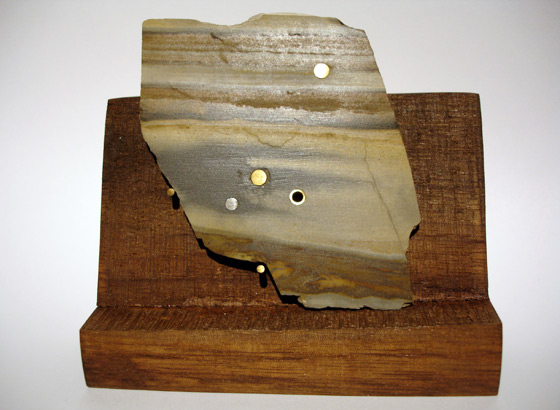
Geoffrey Hendricks
From Job Interview to FluxLux,
a 32 year friendship with Bob Watts
Jill Johnston in her essay, A Fluxus Funeral, about Bob Watts’s memorial celebration FluxLux, speaks of me, "Like Maciunas, and in keeping with one key dress code of Fluxus, Hendricks was in formal gear, however contrarily, to suit his idea of the place and the occasion. With the familiar black derby (a favorite of Maciunas’s), Hendricks wore a black coat that he had bought many years before in Vermont at an antique store. He said it belonged to a farmer who had worn it only once - at a funeral of his brother." Bob was like my older brother so it seemed appropriate. "Hendricks wore black rubber boots, and during the parade to the pond, as he walked along next to the photo cutout of Bob Watts carried by Larry Miller (in a tuxedo), he held a big black umbrella opened overhead, and had a Mexican death mask, made for Mexico’s Day of the Dead, slung around one shoulder." That procession was Philip Corner’s Fourth Finale.

FluxLux celebration and parade on October 17, 1988 in Bangor Pennsylvania
with Larry Miller, Geoff Hendricks, Phil Corner (with a French Horn)
Photo by Francesco Conz
I.
FluxLux was a set of written instructions by Watts for his Last Event, a ceremony that he directed Larry Miller and Sara Seagull to execute with Fluxus friends. They, together with Ben Patterson, Joe Jones, Alison Knowles, Dick Higgins, Philip Corner, Yoshi Wada, Rafael Ortiz, myself, and others realized the event. George Brecht, Eric Andersen, Milan Knížák and Ben Vautier sent scores or texts. A phone call from Al Hansen in Cologne was amplified over the PA system. Francesco Conz came from Italy and Michael Berger from Germany. Many of Bob’s former students and my graduate students were all actively engaged in the organization and performance of the various activities and events. It began with Bob’s iconic piece 2 Inches on the porch roof, and then helium filled balloons stamped with TRACE BOB WATTS were pushed out of the window of the room where Bob died to float up into the blue sky and join Bob’s spirit. It was a fantastically beautiful day. The day was filled with food, music, performance, conversation and fellowship among a great gathering of friends.
There was an auction to raise funds for a Robert Watts Scholarship for the Rutgers’ MFA graduate program that Bob had helped to start. Phil Corner was auctioneer. Joe Jones, Larry Miller and Ben Patterson collaborated to adapt a remote controlled battery-powered boat with a paddle wheel dispenser to spread some of Bob’s ashes into the pond. It took some coaxing from them for it to achieve its mission. There was a 21-gun salute with a variety of funny guns and some real ones fired by members of the local gun club. Ben Patterson as Flux Admiral fired the final shot, a rocket from the canon of his USS Robert Watts that he had built and which capsized when launched. As events at the pond drew to a close, a small plane, at Eric Andersen’s request, circled overhead with a banner saying "MOON." The pilot waved. We waved back. The day ended with a score sent by Allan Kaprow, What’s Watts’ Watts, where we added up the wattage of all the lights in Bob’s house, turning them on as we counted, with Larry Miller announcing the totals, and leaving the house ablaze as we departed into the fading evening light.
II.
My friendship with Bob Watts began in the Spring of 1956 when I went out to New Brunswick, New Jersey as a candidate for a new position in the art department of Douglass College, Rutgers University. There we met and bonded. He had started teaching art in 1953. In 1952 he had taught at the Rutgers College of Engineering. He told me about old loft-like spaces in the area that I could move to for work and living, wanting to make me a neighbor, but I was rooted to New York. Bob liked being in the country while I enjoyed the energy and proximity of the city. However, there was always frequent travel between the two worlds.
Bob and I were rebels in the department, questioning the process of education and the structure of the curriculum, and through exhibitions and programs we brought new ideas to the campus. In the Spring of 1958 Bob was catalyst for getting John Cage to the college for his lecture on Communication and providing the venue for Allan Kaprow’s first Happening. Allan Kaprow had joined the Rutgers College art department also in 1953. He became friends with George Segal, and Bob Watts with George Brecht, who as a research chemist at neighboring Johnson & Johnson had a common background in science. In 1957 Bob, Allan and George Brecht began working on a proposal called Project in Multiple Dimensions. Bob and I spearheaded curriculum changes, later joined by Roy Lichtenstein who we hired in 1960. In that environment Roy developed into a Pop Artist. In an interview he speaks of how being at Rutgers and his conversations with Allan Kaprow were instrumental to this development. In the late fifties we had a diversity of expression and attitude, an openness and curiosity that permitted us as teaching artists to take an experimental approach to education. Allan Kaprow introduced the word "happening" into the vocabulary, George Brecht the word "event." Bob Watts with his engineering background introduced concepts of multi-media. The three generated a kind of alchemical pedagogical thinking that had a profound influence on not just the Rutgers art curriculum, but also the course of 20th century art. I arrived at Rutgers with a background in experimental education, and a decade later I brought George Maciunas to the campus with his Flux-Mass and Hermann Nitsch with his Orgies-Mysteries-Theatre.
In 1963 sitting beside the swimming pool at Watts’s Corbusier-like house of glass and concrete that he built into a hill in Mountainville, New Jersey, Bob read me letters he had received from George Maciunas when he was in the hospital in Wiesbaden for extreme asthma attacks, and Bob showed me his response in the Hospital Event cards that he was making to entertain George. In April 1963 Al Hansen organized a program of Happenings, Events and Advanced Music, at Douglass College. Ben Patterson, Dick Higgins, and Alison Knowles had just returned from Europe, and were joined by Brecht and Watts, Joe Jones and others. In the next decade these artists were in Asolo realizing projects with Francesco Conz.
III.
In 1960 Bob brought his early, motorized pieces with lights into the office we shared. He had a gleam in his eye and a smile at what he had made. Later he appeared with his stamps and for a faculty show in our gallery he installed a stamp machine. He showed me objects he had chrome plated. He was not content to keep making the same thing. Once he solved a problem he wanted to move on to something else. He was a scientist not a manufacturer, although later in the sixties he did start Implosions, Inc. In an interview with Larry Miller he says that if reincarnated he would like to return as a "scientific monk." He found pleasure in solitude, but in addition to his need for the country he needed the city, and was there with George Maciunas organizing Flux Lofts, and took a floor in the one at 80 Wooster Street. He was also involved with George Maciunas in the New Marlborough farm project, and was catalyst for the idea of it becoming a school, a kind of new Bauhaus or Black Mountain College. Bob wanted to develop something there that could free him from Rutgers, but it was never possible to be realized. In 1968-69 Bob was at the University of California/Santa Cruz with a grant from the Carnegie Foundation developing an experimental program that he began at Douglass College. He brought George Maciunas out to formulate educational ideas with him, and he contributed to the publication, Proposals for Art Education, published in 1970 that documented the study. Nye Ffarrabas (aka Bici Forbes) and I visited Bob in Santa Cruz after being at Tassajara Zen Mountain Center. He showed us his gun collection and took us to a nudist beach.
George Brecht and I had talked of how there should be a Festschrift celebration of George Maciunas, and then when Maciunas was attacked by mafia electricians who were working on a Flux loft and he had lost an eye, it seemed to be the time to do it. So in 1976 together with Bob Watts, Dick Higgins, Alison Knowles and others, we organized a surprise banquet at Zaccar Offset, the printing company where George had many things printed. I made a leather covered book/box with all the contributions and was master of ceremonies. Bob Watts together with Sara Seagull produced an issue of the V TRE Fluxus newspaper, Laudatio Scripta pro George Maciunas.
After my partner Brian Buczak died from AIDS related causes on July 4, 1987, Bob presented me with a box containing a small object, a rectangular slice of striated rock with some little pieces of metal embedded, entitled Cosmic Credit Card for Brian & Geoff together with instructions on how to place it on the enclosed walnut base,

Robert Watts: Cosmic Credit Card for Brian & Geoff, 1987
7.5 x 8 x 3 cm, sandstone, brass, steel and walnut
Photo by Ethan Shoshan
a product of his thinking about my communicating with a close friend no longer here, but also reflecting his interest in paranormal phenomena.
IV.
With Flux Med, this final cycle of Bob Watts, the imagery echoes back to many of his earlier pieces, to his postage stamps, to his friendship with George Brecht, to his interest in Ancient American Art, Northwest Coast Indian Art, and African Art that of course includes Egyptian Art, his interest in Dada and Surrealism, Marcel Duchamp and Max Ernst, and to his training as an engineer. Mechanical structures and fantastic engineering pervade the images. These images were made in 1987. He died of lung cancer one year later on September 2, 1988. He must have had some conscious or unconscious awareness of this condition developing within his body. It is as if in Flux Med "Dr. Bob" is embarking on a creative self heal. Flux Cure, Flux Transplant, Hydro-Flux, NY Health Club, 1873. The titles alone reference medicine.
In the map of High-Tech Display the woman is pregnant with both Kentucky, where Bob graduated from the University of Louisville with a degree in Mechanical Engineering, and Pennsylvania, where Bob lived at the end of his life, and where he died. The hand of the woman rests on Pennsylvania. Bob was a Gemini and wanted some of his ashes to be sent into space towards that constellation. In Flux-Twin Game is that a box of cigarettes in the hand coming out of the chest of the double-headed Gemini figure? In BUDDHA at Work, the men are pulling something through the chest of the Buddha-like figure with deformed legs. Is it an extraction of the cancer or an internal tug of war? Is it about a cure through Buddha and meditation? In Flux Transplant five hands are inserting metal objects into a cut foot. Is the reclining figure in the middle of NY Health Club 1873 in a kind of artificial lung? In Out of the mouth of babes the butterflies hover where air moves in and out of the lungs. In this last cycle of collaged images his body seems to be speaking through his hand, eye and mind.
New York, March 2008
Published in: Robert Watts. Flux Med, exhibition catalogue, Artpool, Budapest, 2008, pp. 30-38.